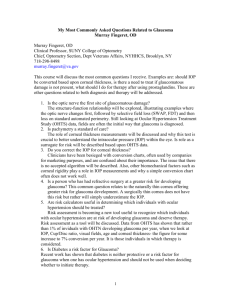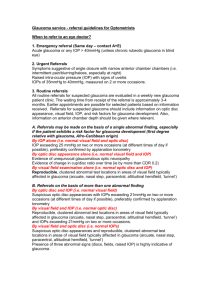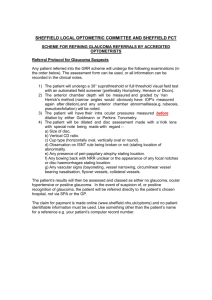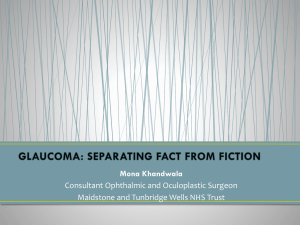outline31243
advertisement
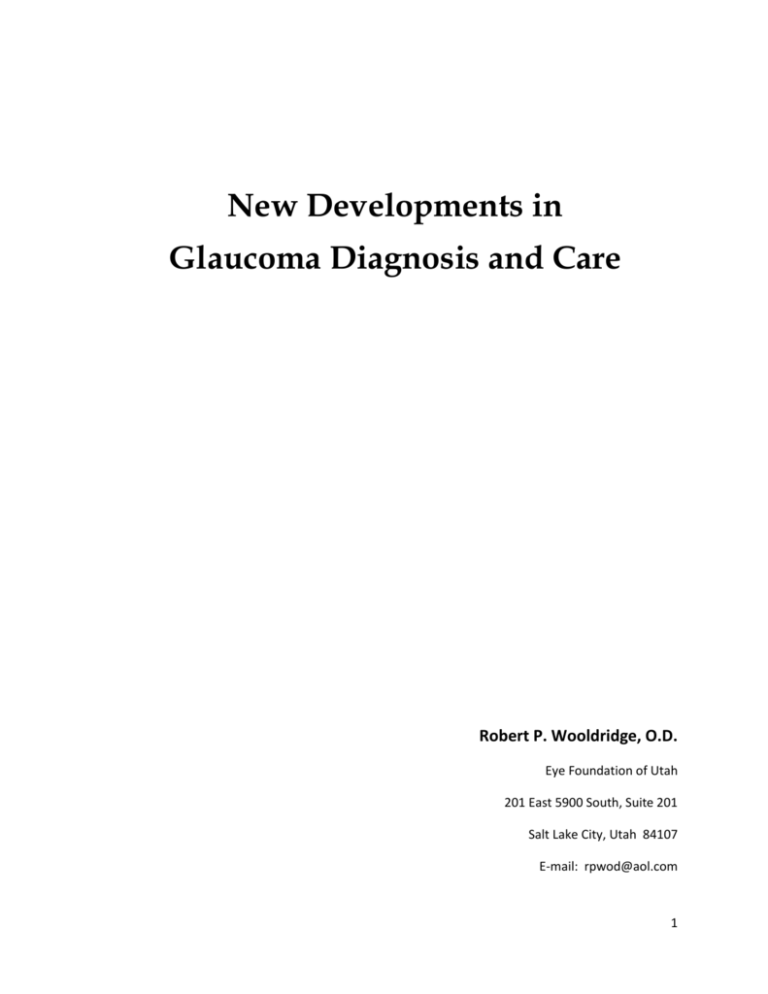
New Developments in Glaucoma Diagnosis and Care Robert P. Wooldridge, O.D. Eye Foundation of Utah 201 East 5900 South, Suite 201 Salt Lake City, Utah 84107 E-mail: rpwod@aol.com 1 New Developments in Glaucoma Diagnosis and Care Disclosure Speakers bureau for: Alcon, Allergan, Heidelberg Engineering, Inspire, Konan Carl Zeiss Meditec, Oculus, Optovue, RPS, VSP Consultant for RPS Ranae March 13 63 yo WF glaucoma suspect H/o extreme drop in BP x 2 secondary to meds in prep. for angiogram S/P bypass (6) +HTN Lotension, Zocor, ASA FH: neg for glaucoma Ranae 20/25, 20/20 TA R: 18, L: 19 Gonio: slit-closed 360 O.U. + bombe CCT R 503 L 491 Discs, VF as seen Ranae June 17 R: 15, L: 19 Now use Betoptic O.U. CCT R 503 L 491 Cause? Effect? The Questions Do we have an accurate, valid means of measuring blood flow to the optic nerve? That is clinically useful? Does blood flow to the optic nerve matter in glaucoma? Can we affect blood flow to the optic nerve? Do we have any evidence that doing so improves the prognosis in glaucoma? What Do We Know? What Do We Not Know? The First Charge There is no accurate, repeatable, verifiable method of measuring blood flow to the optic nerve head. The instruments purported to do so do not agree. 2 We have no means of measuring blood flow to the nerve in a clinically useful fashion Optic Nerve Blood Flow in Glaucoma “Because of its variable arterial origins, small vessel caliber and multilaminate architecture, the microvascular circulation of the optic nerve head is very complex and hard to evaluate with our current technology.” Color Doppler Ultrasound Imaging: “ This is a highly variable technique and requires a capable ultrasonographer with a good knowledge of the anatomy of the globe, a steady hand, a good eye for waveforms, and a good ear for the sounds of the velocities to obtain an acceptable co-efficient of reproducibility.” Optic Nerve Blood Flow in Glaucoma Heidelberg Retinal Flowmeter (HRF) “A limited depth (of scan) makes the vasculature within the lamina inaccessible. Also, the measurements may vary depending on the characteristics of the imaged tissues and the level where the measurements are made…at the level of the retina or at the bottom of the excavation.” “Each of the presently available blood flow measurement techniques requires better validation. Sources of variability should be accounted for and minimized.” Optic Nerve Blood Flow in Glaucoma “There is no reliable method to measure accurately the blood flow in the optic nerve head.” World Glaucoma Association Consensus Reports Structure and function in the management of glaucoma Glaucoma surgery: open angle glaucoma Angle closure glaucoma Intraocular pressure Glaucoma screening Ocular blood flow in glaucoma WGA Consensus on Blood Flow Ft. Lauderdale on May 2, 2009 Goals: To obtain consensus on the relationship between ocular blood flow and glaucoma To establish a foundation for OBF research of glaucoma and the best practice for its testing in clinical practice. Consensus statements and comments based on published literature and expert opinion Clinical Measurement of Ocular Blood Flow Consensus Points Color Doppler Imaging (CDI)…measures blood flow velocity and calculates resistive index in the retrobulbar vessels Comment: CDI does not measure flow 3 The measurements with one CDI instrument are not necessarily compatible with those of another Scanning Laser Doppler Scanning Laser Doppler flowmetry measures velocity, volume and flow limited to the retinal microcirculation and the optic nerve head Comment: There is a lack of standardization for analysis, and flow is limited to arbitrary units of measure. Comment: the depth of the measurements is not known and may not be comparable among subjects. Ocular Pulse Amplitude The relationship between OPA and total blood flow to the eye and, specifically, to the optic nerve is uncertain Significance is controversial “OPA should not be used as a surrogate for ocular blood flow measurement” Pulsatile Ocular Blood Flow Analyzer Advantages: relatively inexpensive, simple to operate, data acquired immediately, requires no special training,..and is minimally invasive for the patient. Disadvantages: Measures IOP rather than blood flow, and the rate of venous blood flow is not known Pulsatile Ocular Blood Flow Analyzer POBF values are influenced by age, gender, BP, pulse and axial length Decreases significantly with age “The wide range of normal values and the low discriminating power ofPOBF between normal and glaucomatous limits the clinical use of the device.” “POBF was found not to be an adequate measure of total ocular blood flow.” Consensus Point At the present time, there is no single method for measuring all aspects of ocular blood flow and its regulation in glaucoma. The Question Do we have an accurate, valid means of measuring blood flow to the optic nerve? That is clinically useful? Does blood flow to the optic nerve matter in glaucoma? The Second Charge Blood supply to the nerve plays no significant role in the risk of glaucoma developing or in the natural progression of the disease. 4 The Evidence Against Blood Supply as a Risk Factor for Development of Glaucoma Ocular Hypertension Treatment Study (OHTS) What are the risk factors for the development of glaucoma? Study design 1636 Patients: 40 - 80 yo IOP 24 - 32 in one eye, and IOP 21 - 32 in fellow eye Normal VF and nerves Univariate and Multivariate Older age Higher IOP Greater pattern standard deviation Thinner central corneal thickness Larger vertical C/D ratio Factors NOT Predictive (U and M) Migraine Cerebral vascular accident High OR low blood pressure Use of oral Beta blockers Calcium channel blockers Diabetes Found to be protective in both univariate and multivariate analyses Later reassessed and found to be neither protective nor a risk factor OHTS Validated by EGPS OHTS prediction model applied to European Glaucoma Prevention Study control patients Risk of developing glaucoma OHTS: 9.3% EGPS: 16.8% Same risk factors identified Age, IOP, CCT,C/D and PSD VF Diabetes did NOT decrease or increase risk in EGPS The Evidence Against Blood Supply as a Risk Factor for Progression of Glaucoma Early Manifest Glaucoma Trial To assess factors for progression of glaucoma Study design 255 patients with mild glaucoma ½ treated ½ followed without treatment Treatment group ALT plus Betoptic 0.5% bid 5 Control group No treatment Progression (median FU 6 yrs.) Control group: 62% Treatment group: 45% Risk Factors at Baseline Higher baseline IOP Exfoliation Both eyes eligible (bilateral disease) Worse mean deviation on VF Older age Baseline Factors-No Added Risk High blood pressure Cardiovascular disease Migraine or Raynaud’s Disease Smoker (current or prior) Glaucoma family history Sex Central Corneal Thickness! (CCT) Refractive error What About Normal Tension Glaucoma?? Optic Nerve Blood Flow in Glaucoma “There is little direct evidence of vasospasm in the optic nerve head itself in NTG. The evidence is based on the findings of vasospastic response of the fingernail vascular bed to cold or other vasospastic disorders in these patients.” Collaborative NTG Study Risk factors for progression of VF abnormalities in NTG 160 subjects Traits that make a person more likely to have NTG. Older age Female gender H/O Migraine (Japanese) Higher IOP (but still normal) 17-22 Traits That Affect the Rate of Progression if Untreated Female gender Migraine Disk hemorrhage at baseline Racial Heritage 6 Asians longer survival time 2527 days Whites medium 1985 days Blacks shortest 1282 days Too few black patients to be statistically significant Age is NOT a factor in rate of progression Vascular Risk Factors Evaluated Blood pressure Pulse rate Cardiac arrhythmia Major cardiovascular crisis Hypotension Shock Blood transfusuion Major surgery Vascular Risk Factors Evaluated Cardiovascular disease HTN Angina Myocardial infarction Diabetes mellitus Peripheral vascular disease Migraine Raynaud phenomenon Anemia Tendency for low blood pressure Family history of DM and stroke Results “HTN, H/O major surgery, FH of Stroke or DM occurred in a substantial percentage of patients but failed to show up as factors influencing the rate of deterioration.” Migraine and disc hemorrhage were the only factors shown to affect the course of NTG Are these factors evidence of too little blood flow or too much?? (vasodilation?) Risk Factors That Did Not Affect Risk of Progression Cardiovascular disease HTN Angina Myocardial infarction Diabetes mellitus Peripheral vascular disease Raynaud phenomenon Anemia Tendency for low blood pressure 7 Family history of DM and stroke The Evidence For Blood Supply as a Risk Factor for Development of Glaucoma Systolic BP and Glaucoma IOP is positively (but weakly)correlated with BP For every 10mm change in SBP, there is a 0.5mm change in IOP Association between BP and the development of glaucoma is weak Barbados Eye Study Low SBP was a risk factor for incidence of OAG EMGT: Low SBP was a predictor for progression Consensus Points Blood Pressure is positively correlated with IOP. It is unclear whether the level of BP is a risk factor for having or progressing OAG in an individual patient. Lower OPP is a risk factor for primary OAG. OBF parameters measured with various methods are impaired in OAG, especially in NTG Consensus Points, cont. Vascular dysregulation may contribute to the pathogenesis of glaucoma, more likely in people with lower IOP. Conclusion “The relationship among BP, IOP and development of OAG is complex and requires further investigation.” A New Way to Assess OBF: Ocular Perfusion Pressure Ocular Perfusion Pressure: Terminology OPP – Ocular Perfusion Pressure SPP – Systolic Perfusion Pressure DPP – Diastolic Perfusion Pressure MPP – Mean Perfusion Pressure Ocular Perfusion Pressure and Glaucoma SPP = SBP – IOP DPP = DBP – IOP MPP = 2/3 mean arterial pressure – IOP Arterial Pressure = DBP + 1/3(SBP – DBP) OPP: Baltimore Eye Survey Cross sectional study of African Americans and Caucasians in Baltimore, MD Lower OPP strongly associated with prevalence of POAG 8 Sixfold excess of POAG in subjects with lowest category of OPP OPP: The Egna-Neumarkt Study Population-based cross-sectional study of Caucasians in Northern Italy Lower DPP associated with marked, progressive increase in frequency of POAG OPP: The Egna-Neumarkt Study OPP: Barbados 9-year Same cohort study of African-Caribbeans residing in Barbados, West Indies 9-year risk of developing glaucoma increased dramatically at lower SPP (RR 2.0, CI 1.1 – 3.5) DPP (RR 2.1, CI 1.2 – 3.9) MPP (RR 2.6, CI 1.4 – 4.6) POAG Risk Factors 9-year BES OPP: Proyecto VER Cross-sectional study of Hispanics in Nogales and Tucson, AZ Found lower DPP associated with increased risk of POAG Subjects with DPP OPP: Proyecto VER OPP in EMGT Randomized clinical trial comparing no treatment to treatment for initially diagnosed glaucoma (entire cohort followed for progression) In patients with higher baseline IOP: h/o CVD increased risk (HR 2.75, CI 1.44-5.26) Lower SPP increased risk (HR 1.55, CI 1.02-2.35) In patients with lower baseline IOP: Higher systolic BP decreased risk (HR .44, CI .2-.97 Lavon 2/11 36yo WF referred as glaucoma suspect MH: no illnesses; no migraines VA 20/15 OU Ta: R 26 L 25 CCT: R 595 L 608 DCT: R 28 L 23 Lavon 3/11 Ta: R 27 L 27 9 BP: 109/66 DOPP: 66-27=39 Plan: Advised of ORB of Rx v. no Rx, asymptomatic nature of early glaucoma and need for careful FU Will follow without Rx for now Can we affect blood flow to the optic nerve? The Third Charge We can do nothing to selectively improve blood supply to the nerve without possibly affecting blood supply to other tissues of the body and placing them at risk for ischemia. The Fourth Charge There are no therapeutic agents that improve the natural course of glaucoma by increasing blood supply to the optic nerve. Vasodilators “The magic pills” Despite being available for many years… Despite the high prevalence of glaucoma… Despite the huge potential profitability of any vasodilating agent if proven to be effective in the management of glaucoma… There are no agents proven to be effective in selectively increasing blood supply to the optic nerve or approved by the FDA for the treatment of glaucoma Optic Nerve Blood Flow in Glaucoma “A number of studies have found no significant benefits from the use of calcium antagonists in glaucoma.” “Calcium antagonists can cause nocturnal hypotension, which, in addition to other systemic side effects, adversely effects the blood flow in the optic nerve head.” “In view of these considerations, there seems to be little scientific basis for use of calcum channel blockers in glaucoma treatment.” Impact of Ocular Medications on OBF Clinical Control of OPP Lower IOP improves OPP Higher systemic BP improves OPP but don’t necessarily want to raise BP Stroke #3 cause of death in US behind CVD and CA! Avoid drugs that lower systemic BP beyond patient’s desired systemic control Avoid nocturnal hypotension 10 Nocturnal Hypotension and OPP Low BP at night, coupled with high IOP in supine position, compromise OPP Using systemic BP meds in the AM to minimize nocturnal hypotension makes sense Using IOP lowering drugs that lower IOP while sleeping makes sense Avoiding IOP meds that LOWER systemic BP at night (beta blockers, alpha agonists) makes sense Travoprost Reduces and Sustains Habitual IOP-lowering Nocturnal and Diurnal Habitual IOP Brinzolamide, Timolol added to Latanoprost Brimonidine Habitual Position OPP and Glaucoma Medications Cross over study of effect of different classes of IOP lowering meds on DPP PGA and CAI significantly increased DPP at all time points Beta-blocker significantly increased DPP from 4AM to 4PM but had no effect at other times Alpha agonist significantly reduced DPP at multiple time points, primarily due to significant decrease in systemic BP OPP and Glaucoma Medications Nocturnal and Diurnal Habitual IOP Travoprost Reduces and Sustains Habitual IOP-lowering Clinical Relevance of OBF Measurements Including Effects of General Medications or Specific Glaucoma Treatment Ocular medications and OBF Pilocarpine: no significant effect.1 Phenylephrine: produced vasoconstriction in retrobulbar arterioles around the ONH.2 Brimonidine: no change in retinal capillary flow.3 Increase in OBF in POAG4 and NTG.5 No change in OPA.6 Ocular Medications and OBF Brimonidine: no change in retinal capillary flow.3 Increase in OBF in POAG4 and NTG.5 No change in OPA.6 11 Beta Blockers Patients using topical beta blockers had: Lower minimum nocturnal heart rate Lower minimum nocturnal DBP Greater percentage drop in nocturnal DBP Beta-blockers: Timolol: Controversial Most studies report no significant or rather unfavorable results.1 Betaxolol: Reports vary: beneficial or not significant More favorable than Timolol Prostaglandin Analogues Latanoprost, Bimatoprost and Travoprost Generally show beneficial effects on retrobulbar hemodynamics Carbonic Anhydrase Inhibitors Dorzolamide, Brinzolamide: Reports mixed but more showed positive effects on OBF Others showed no significant effect Consensus Point Certain drugs, even when formulated in an eye drop, may have an impact on ocular blood flow and its regulation. Comment: The impact of eye drop related changes in OBF on the development and progress of glaucoma is unknown. Some data support increased blood flow and the enhancement of OBF regulation with CAI’s. These appear to exceed what one would expect from their ocular hypotensive effect alone. Role of Systemic Medications? Some systemic medications may have an impact on OBF and its regulation. Comment: The impact of systemic medications altering OBF on the development and progression of glaucoma is unknown. Classes of systemic medications that have been reported to increase OBF include Calcium channel blockers Angiotension converting enzyme inhibitors Angiotension-receptor inhibitors Carbonic anhydrase inhibitors Phosphodiesterase-5 inhibitors Larry 1999 46 yo WM referred as glaucoma suspect MH: no illnesses FH: mother has glaucoma 12 VA 20/15 OU IOP R 42 L 46 SLE normal OU ON, VF as seen Your Plan? 1. Xalatan qhs OD 2. Xalatan qhs OU 3. Timolol bid OU 4. Trusopt bid OU Feb. 15, 1999 IOP R 21 L 38 Gonioscopy Grade IV OU Now use Xalatan OU 1999-2002 Managed with Xalatan, Alphagan and/or Betoptic Some problems with irritation, pterygium IOP’s running 19-26 OU 11/15/2002 On Xalatan OU CCT R 597 L 581 IOP R 21 L 20 VF normal OU 2/17/03 Using Xalatan OU IOP R 37 L 37 Plan: Continue Xalatan OD D/C Xalatan OS 2/21/03 IOP R 23 L 38 2/21/03 IOP R 19 L 22 Resume Xalatan OU Discussed ORB of gtt, SLT, trabeculectomy 3/3/03 IOP R 19 L 22 SLT OS done today 6/17/03 IOP R 26 L 19 + response to SLT; schedule SLT OD 13 2003-2006 IOP running 15-17 OU on Xalatan, after SLT OU VF, nerves stable 9/06/06 IOP R 16 L 17 11/27/06 Still on Xalatan OU IOP R 27 L 27 HRT as seen ON photos stable OU But… New disc hemorrhage OS What is Your Plan? 1. Continue Xalatan OU 2. SLT OU 3. Switch to Travatan OU 4. Add Azopt bid OD Rob’s Plan 1. Switch to Travatan OU 2. Add Azopt OD bid 3. Schedule SLT OS 7/10/2007 SLT OS performed 12/15/06 Back on Xalatan OU IOP R 21 L 22 VF normal OU 2009 S/P SLT OU 2003 Currently taking Xalatan, Combigan OU VA 20/20 OU IOP June 29 R 16 L 14 July 30 R 12 L 13 ON,VF as seen Larry 2009 IOP running R 12-17 L 13-14 On Xalatan and Combigan VF getting worse OD Now what? Other Health Issues? No sleep apnea No migraines 14 What else should we check?? BP June 29: 102/56 P 48 July 30: 121/74 P 51 What is Your Plan? 1. Add Cosopt 2. Add Azopt 3. More SLT 4. Refer to someone you don’t like Clinical Control of OPP Lower IOP improves OPP Higher systemic BP improves OPP but don’t necessarily want to raise BP Stroke #3 cause of death in US behind CVD and CA! Avoid drugs that lower systemic BP beyond patient’s desired systemic control Avoid nocturnal hypotension Nocturnal Hypotension and OPP Low BP at night, coupled with high IOP in supine position, compromise OPP Using systemic BP meds in the AM to minimize nocturnal hypotension makes sense Using IOP lowering drugs that lower IOP while sleeping makes sense Avoiding IOP meds that LOWER systemic BP at night (beta blockers, alpha agonists) makes sense Take Home Points The role of blood supply as a risk factor in glaucoma is poorly understood and remains controversial Be aware of vascular health issues in our glaucoma patients Blood pressure Sleep apnea dyslipidemia Take Home Points Encourage good lifestyle habits Diet Exercise Avoid headstands with yoga Stop smoking Refer for appropriate evaluation and management of possible risk factors Blood pressure: avoid nocturnal hypotension Sleep apnea Vasospasm 15

